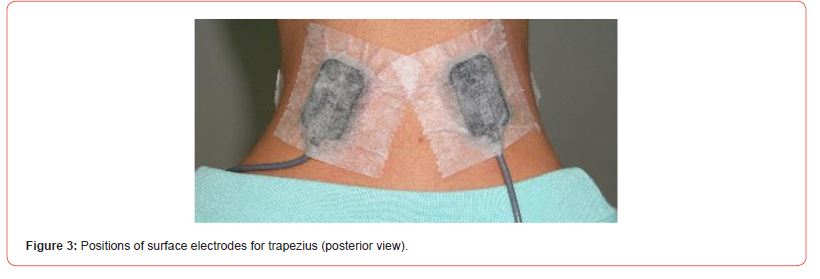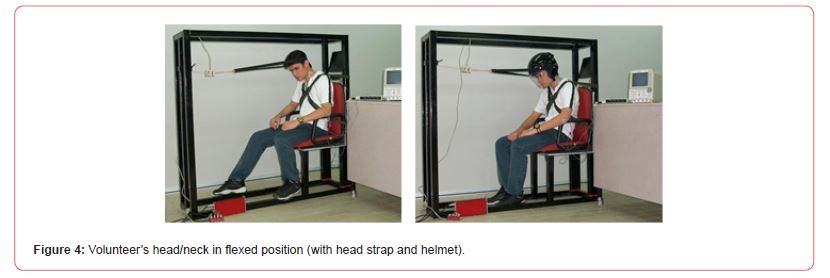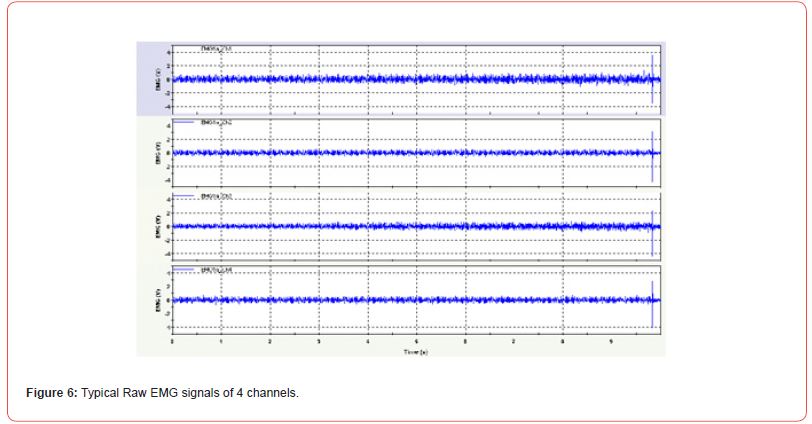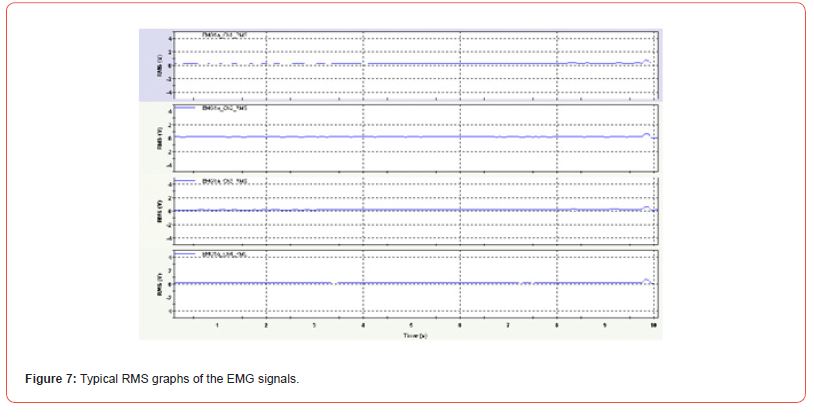 Research Article
Research Article
Experimental Study: - Maximum Resisting Forces (Isometric/Isotonic) Of Head/Neck in Sagittal Plane
Chong Lun Xu1, Ee Chon Teo*1
1Faculty of Sports Science, Ningbo University, China
Ee Chon Teo, Faculty of Sports Science, Ningbo University, China.
Received Date: June 16, 2023; Published Date: June 30, 2023
High-impact forces applied to different head/neck positions can cause bodily damage. Studying the maximum neck force tolerance in different head/neck postures under high-impact conditions is valuable for injury prevention and head/neck mechanisms study. This study aimed to determine the maximum neck force tolerance under different head/neck postures, considering the influence of different directions and sizes of the impact force. This report summarizes the firing patterns and muscle activation of the two surface cervical neck muscles, sternocleidomastoid and trapezius, based on the difference in the action potentials of the captured Electromyography (EMG) signal of the surface electrodes using Delsys Bangnoli-4 EMG System. Two different test setups based on the posture of the head/neck and boundary conditions in resisting pulling force. Five volunteers with weight between 53-80 kg and height of 1.63-1.82 m participated in the study. Under isometric contraction conditions, a maximum force of 29.88 kg was recorded with extended head/neck posture. For isotonic contractions, the maximum force was 31.60 kg recorded for movement of head/neck from flexed posture to its upright posture. The study found that different contraction conditions and different head/neck postures, the maximum neck force tolerance is different.
Keywords:Cervical; Firing; Isotonic; Isometric; Muscles; Sternocleidomastoid; Trapezius
Abbreviations:EMG: Electromyography
Introduction
Head-neck system is a complex biomedical linkage with multiple degrees of freedom of movement [1-4] whereby various neck muscles are irritated and contracted (isometric or isotonic) in concern to control the head and neck movement. The magnitude and direction of impact force acting on different postures of head/ neck commonly occurred in high-speed activities, such as punching in kickboxing [5] and pilot emergency ejection [6]. Exceeding the magnitude of force tolerance of the neck can cause high risk of injury, such as soft tissue injuries to the spine, cervical disc degeneration, ligament tears, muscle strains, and cervical fractures. As sternocleidomastoid and trapezius are two muscles mainly responsible for the movement of the neck (flexion, extension and hyper-extension) in the anatomical sagittal plane to protect against impact injuries, hence this study aimed to investigate their activation using EMG signal output from surface electrodes [7- 9] and determine the maximum neck force tolerance in resisting a pulling forward force (isometric contraction) and pushing backward force (isotonic contraction) with head/neck in flexed, neutral and extended postures.
Materials and Method
Tests were conducted on five volunteers. For each test, the volunteer is secured firmly using a chair that does not move with the force when applied. Shoulder straps are tightened across the body to prevent its movement with force. The loading device or setup is placed at a distance, determined by the height of the volunteer, such that the tangent of the body height and the distance of body to the setup, gives the desired angle of loading. A head strap/helmet also tightened around the volunteer’s head to enable the transmission of the force from the load cell to the head and thus the neck. The loading setup consisted of a load cell, strong cable, and a height-adjustable drum for increasing load purposes. To minimize experimental errors, the loading setup has to be heavy and remain stationary on the ground to prevent the change in the angle of loading as a result of change in the distance between the chair and the loading setup during loading.
[Figure 1] shows the experimental set-up and its accessories. It consists of the experimental rig; load cell; strain meter (calibrated); oscilloscope, and Delsys Bangoli-4 EMG System. [Figure 2] and [Figure 3] show the placing of the surface electrodes on the volunteer’s neck sternocleidomastoid and trapezius, respectively. Before actual conducting of test on the volunteer, calibration of the load cell using both the tensile loading machine and dead weights is done. Thus, the magnitude of the force experienced can be determined from the recorded voltages. For each test, the volunteer is secured to the chair through the use of shoulder straps to prevent the exertion of strength from the lower body to resist the force loaded, and with the adjustable drum height almost aligned volunteer’s eyes level. Then the load cell connected to the head strap is tied around the head. The load cell is set at a level so that the restraining strap sloped downwards at approximately 5-10 away from the subject’s head. Then the subject’s head is pulled against the head strap with the subject’s neck in: - (i) normal upright position; (ii) flexed position, and (iii) extended position, and each corresponding increasing load cell and EMG readings are recorded accordingly (isometric contraction).



After these three tests, with the same volunteer, the load cell is lowered to produce a 45 downward slope away from the subject’s head in the restraining strap. Then the subject’s head is pulled against the strap with the subject’s neck from: - (iv) flexed to normal upright position, and (v) upright to extended position, and load cell and EMG readings are recorded accordingly (isotonic contraction). These tests are repeated with the head strap replaced by the helmet. [Figure 4] shows a typical setup of the test with the head/ neck in the flexed position (Test (ii)). Three sets of readings are taken for each test. The first and second sets of readings are taken on the same day, with an interval of one-hour rest in between them. The third set of readings is taken one week later. After that, these three sets of readings are averaged out by dividing their sum by three. From these preliminary studies, it is concluded that using the helmet is a better experimental set-up compared to using the head strap. Subsequently, the experiment is continued on five volunteers to determine the maximum force that the neck muscle can exert for each task and the firing pattern of the sternocleidomastoid and trapezius.

Results
[Figure 5] shows a typical oscilloscope graphical plot, Y-axis represents the magnitude of load, in term of voltage, exerted on the neck muscles when the load cell is wound obtained from one volunteer in the five tests. [Table 1] shows mean readings of the maximum loads of each volunteer under five different tests, and the mean maximum load for each test from these five volunteers. From the results tabulated in [Table 1], it shows that with the head/neck in the neutral upright posture (Test (ii)) has the least maximum load (28.21 kg) and in its movement from flexed posture to neutral upright posture (Test (iv)) has the largest maximum load (31.60 kg). From the EMG signals obtained, as shown in [Figure 6], it is difficult to visualize the gradual increase in the EMG signal amplitude when there is an activation/firing of the muscles under investigation with increasing loads. Similarly, from the calculated RMS graphs [Figure7], the time of muscle activation is not obvious from the surge in the RMS value.
Table 1:Mean Maximum Load for the 5 Tests.




Discussion
Before performing the five tests, the two surface muscles, sternocleidomastoid and trapezius, are located on the volunteer. This process of locating these two muscles and placing of surface electrodes on these muscles are important. The surface electrodes need to be placed on the mid belly of the muscles investigated and aligned parallel to their muscle fibers. Following that is the placement of the reference electrode, which also plays an important role in obtaining the EMG signals. It is placed as far as possible from the EMG electrode; on an electrically neutral tissue (such as a bony prominence); has good electrical contact with skin, and on a mechanically stable location which will not be pulled off easily. In the mist of the test, data is obtained from the five volunteers and the oscilloscope graphs collected are analyzed. Only the maximum load exerted on each test is determined based on the peak of the oscilloscope graphical plot. The time of collapse is not able to be determined from the oscilloscope as the loading of the load cell is done manually and not at a constant rate, thus the rate for each test is not standard. Therefore, the time of collapse cannot be concluded from the graphs obtained.
The analysis of the captured EMG signals and its RMS EMG plots neither clearly show the exact activation of isometric contraction in Test (i), (ii) and (iii), non-isotonic contraction in Test (iv) and (v) of these muscles. However, the maximum force for each Test’s setup is obtained, notably all other muscles may be acting in concert. The effectiveness of the surface electrodes and Delsys Bangoli-4 equipment used in this study in capturing reliable, repeatable and stable EMG signal is doubtful. Wire electrodes and high sensitive equipment be used for future investigations.
Conclusion
In this study, five volunteers were involved to determine the maximum force in resisting the forward pull of the head/neck in flexed, upright and extended postures (Test (i), (ii) and (iii)). Maximum isometric contraction force of 29.88 kg was recorded in extended head/neck posture. In Test (iv) and (v) the volunteers were exerting backward pushing movement of the head/neck posture from flexed to neutral upright position; then from neutral upright to extended position, respectively. Isotonic contraction of muscles was activated, maximum force of 31.60 kg was recorded in the former movement. This data provides insights for personnel involved in high-speed activities, such as punching in kickboxing, heading of ball, and emergency pilot ejection, etc. whereby high impact force may induce in any head/neck posture unexpectedly. The results also provide valuable data for rehabilitation of head/ neck therapy.
Acknowledgement
None.
Conflict of interest
No conflict of interest.
References
- Gerard J Tortora, Sandra R Grabowski (2001) Introduction to the Human Body- The Essentials of Anatomy and Physiology 5th Edition.
- http://normandy.sandhills.cc.nc.us/psy150/neuron.html.
- Elaine N Marieb (2016) Essentials of Human Anatomy and Physiology: 317 10th Edition.
- Evelyn Pearce (1975) Anatomy and Physiology for Nurses: including notes on their clinical application 16th Edition.
- Mosa Pashaei, Farde Babakhani and Kambiz Banihashemi (2023) Evaluation of surface electromyography of selected muscles during the whiplas mechanism in aware and unaware conditions due to safe punching in kickboxing. BMC. Musculoskelet. Disord. 24(1): 429.
- Tian-Cheng Li, Chun-Jie Liu, Song-Yang Liu, Xin Wang, JingJing Feng, et al. (2023) Effect of muscle activation on dynamic responses of the neck of pilot during emergency ejection: a finite element study. Med Biol Eng Comput.
- Don B Chaffin, Gunnar BJ Anderson, Bernard J Martin (2006) Occupational Biomechanics 3rd Edition: 146-150.
- Adam Wittek, Koshiro Ono, Janusz Kajzer, Roland Ortengren, Satoshi Inami, et al. (2001) Analysis and comparison of reflex times and Electromyograms of cervical muscles under impact loading using surface and fine-wire electrodes. IEEE. Trans. Biomed. Eng 48(2): 143-53.
- Carlo J De Luca (1997) The Use of Surface Electromyography in Biomechanics. J. Appl. Biomech 13(2): 135-163.
-
Chong Lun Xu, Ee Chon Teo*. Experimental Study: - Maximum Resisting Forces (Isometric/Isotonic) Of Head/Neck in Sagittal Plane. Aca J Spo Sci & Med. 1(1): 2023. AJSSM.MS.ID.000505.
-
Cervical, Firing, Isotonic, Isometric, Muscles, Sternocleidomastoid, Trapezius, Oscilloscope
-

This work is licensed under a Creative Commons Attribution-NonCommercial 4.0 International License.






